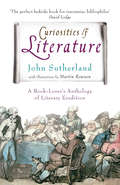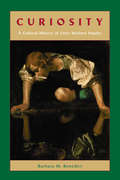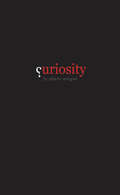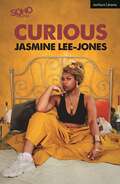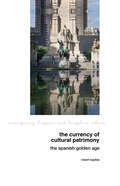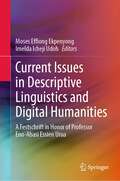- Table View
- List View
Curing queers': Mental nurses and their patients, 1935–74 (Nursing History and Humanities)
by Tommy DickinsonDrawing on a rich array of source materials including previously unseen, fascinating (and often quite moving) oral histories, archival and news media sources, 'Curing queers' examines the plight of men who were institutionalised in British mental hospitals to receive ‘treatment’ for homosexuality and transvestism, and the perceptions and actions of the men and women who nursed them. It examines why the majority of the nurses followed orders in administering the treatment – in spite of the zero success-rate in ‘straightening out’ queer men – but also why a small number surreptitiously defied their superiors by engaging in fascinating subversive behaviours. 'Curing queers' makes a significant and substantial contribution to the history of nursing and the history of sexuality, bringing together two sub-disciplines that combine only infrequently. It will be of interest to general readers as well as scholars and students in nursing, history, gender studies, and health care ethics and law.
Curiosities of Literature: A Book-lover's Anthology of Literary Erudition
by John SutherlandHow much heavier was Thackeray's brain than Walt Whitman's? Which novels do American soldiers read? When did cigarettes start making an appearance in English literature? And, while we're about it, who wrote the first Western, is there any link between asthma and literary genius, and what really happened on Dorothea's wedding night in Middlemarch?In Curiosities of Literature, John Sutherland contemplates the full import of questions such as these, and attempts a few answers in a series of essays that are both witty and eclectic. His approach is also unashamedly discursive. An account of the fast-working Mickey Spillane, for example, leads to a consideration of the substances, both legal and illegal, that authors have employed to boost their creative energies. An essay on good and bad handwriting points out in passing that Thackeray could write the Lord's Prayer on the back of a stamp. As for Mary Shelley, a brief recital of the circumstances in which she wrote Frankenstein stops off to consider what impact the miserable summer weather of 1816 had on the future path of English literature. Of course, it is debatable whether knowledge of these arcane topics adds to the wisdom of nations, but it does highlight the random pleasures to be found in reading literature and reading about it. As John Sutherland rightly asks, 'Why else read?'
Curiosity: A Cultural History of Early Modern Inquiry
by Barbara M. BenedictIn this striking social history, Barbara M. Benedict draws on the texts of the early modern period to discover the era's attitudes toward curiosity, a trait we learn was often depicted as an unsavory form of transgression or cultural ambition.
Curiosity
by Alberto ManguelCuriosity has been seen through the ages as the impulse that drives our knowledge forward and the temptation that leads us toward dangerous and forbidden waters. The question “Why?” has appeared under a multiplicity of guises and in vastly different contexts throughout the chapters of human history. Why does evil exist? What is beauty? How does language inform us? What defines our identity? What is our responsibility to the world? In Alberto Manguel’s most personal book to date, the author tracks his own life of curiosity through the reading that has mapped his way. Manguel chooses as his guides a selection of writers who sparked his imagination. He dedicates each chapter to a single thinker, scientist, artist, or other figure who demonstrated in a fresh way how to ask “Why?” Leading us through a full gallery of inquisitives, among them Thomas Aquinas, David Hume, Lewis Carroll, Rachel Carson, Socrates, and, most importantly, Dante, Manguel affirms how deeply connected our curiosity is to the readings that most astonish us, and how essential to the soaring of our own imaginations.
curious (Modern Plays)
by Jasmine Lee-JonesBeing a woman is blood and gutsIt's intestineFuck florals and ballgownsIt's ballsIt's livers and kidneys and puke and mucusRipping and tearing and shreddingRed stain on linen beddingIt's sheddingJaz is in her second year at drama school. Jaz is tired of performing. Hence her conundrum. But when she stumbles across a piece of forgotten history – her life is changed forever…What does it mean to find yourself? Especially when it seems the world you live in is diametrically set against you doing just that?Set against the sprawling backdrop of urban London across centuries, curious is a frank, funny and moving excavation of the lives of two actresses who are young, Black, queer and trying to find out who they are. It is written and performed by Jasmine Lee-Jones, the winner of Evening Standard Award 2019 and Critics' Circle Theatre Award for Most Promising Playwright for her play seven methods of killing kylie jenner.
curious (Modern Plays)
by Jasmine Lee-JonesBeing a woman is blood and gutsIt's intestineFuck florals and ballgownsIt's ballsIt's livers and kidneys and puke and mucusRipping and tearing and shreddingRed stain on linen beddingIt's sheddingJaz is in her second year at drama school. Jaz is tired of performing. Hence her conundrum. But when she stumbles across a piece of forgotten history – her life is changed forever…What does it mean to find yourself? Especially when it seems the world you live in is diametrically set against you doing just that?Set against the sprawling backdrop of urban London across centuries, curious is a frank, funny and moving excavation of the lives of two actresses who are young, Black, queer and trying to find out who they are. It is written and performed by Jasmine Lee-Jones, the winner of Evening Standard Award 2019 and Critics' Circle Theatre Award for Most Promising Playwright for her play seven methods of killing kylie jenner.
Curious Attractions: Essays on Fiction Writing
by Debra SparkCurious Attractions: Essays on Fiction Writing is a book about what makes fiction work. In nine entertaining and instructive essays, novelist and master teacher Debra Spark pursues key questions that face both aspiring and accomplished writers, including: How does a writer find inspiration? What makes a story's closing line resonate? How can a writer "get" style? Where should an author "stand" in relation to his or her characters? While the book will have immediate appeal for students of writing, it will also be of interest to general readers for its in-depth reading of contemporary fiction and for its take on important issues of the day: Should writers try to be more uplifting? How is emotion best conveyed in fiction? Why are serious writers in North America wedded to the realist tradition? When she was only twenty-three, Debra Spark's best-selling anthology 20 Under 30 introduced readers to some of today's best writers, including David Leavitt, Susan Minot, Lorrie Moore, Ann Patchett, and Mona Simpson. Almost twenty years later, Spark brings this same keen critical eye to Curious Attractions, discussing a broad range of authors from multiple genres and generations. A collection of essays in the belles-lettres tradition, Curious Attractions offers lively and instructive discussions of craft flavored with autobiographical reflections and commentary on world events. Throughout, Spark's voice is warm, articulate, and engaging as it provides valuable insights to readers and writers alike.
The Curious Eye: Optics and Imaginative Literature in Seventeenth-Century England
by Erin WebsterThe Curious Eye explores early modern debates over two related questions: what are the limits of human vision, and to what extent can these limits be overcome by technological enhancement? In our everyday lives, we rely on optical technology to provide us with information about visually remote spaces even as we question the efficacy and ethics of such pursuits. But the debates surrounding the subject of technologically mediated vision have their roots in a much older literary tradition in which the ability to see beyond the limits of natural human vision is associated with philosophical and spiritual insight as well as social and political control. The Curious Eye provides insight into the subject of optically-mediated vision by returning to the literature of the seventeenth century, the historical moment in which human visual capacity in the West was first extended through the application of optical technologies to the eye. Bringing imaginative literary works by Francis Bacon, John Milton, Margaret Cavendish, and Aphra Behn together with optical and philosophical treatises by Johannes Kepler, René Descartes, Robert Hooke, Robert Boyle, and Isaac Newton, the volume explores the social and intellectual impact of the new optical technologies of the seventeenth century on its literature. At the same time, it demonstrates that social, political, and literary concerns are not peripheral to the optical science of the period but, rather, an integral part of it, the legacy of which we continue to experience.
The Curious Eye: Optics and Imaginative Literature in Seventeenth-Century England
by Erin WebsterThe Curious Eye explores early modern debates over two related questions: what are the limits of human vision, and to what extent can these limits be overcome by technological enhancement? In our everyday lives, we rely on optical technology to provide us with information about visually remote spaces even as we question the efficacy and ethics of such pursuits. But the debates surrounding the subject of technologically mediated vision have their roots in a much older literary tradition in which the ability to see beyond the limits of natural human vision is associated with philosophical and spiritual insight as well as social and political control. The Curious Eye provides insight into the subject of optically-mediated vision by returning to the literature of the seventeenth century, the historical moment in which human visual capacity in the West was first extended through the application of optical technologies to the eye. Bringing imaginative literary works by Francis Bacon, John Milton, Margaret Cavendish, and Aphra Behn together with optical and philosophical treatises by Johannes Kepler, René Descartes, Robert Hooke, Robert Boyle, and Isaac Newton, the volume explores the social and intellectual impact of the new optical technologies of the seventeenth century on its literature. At the same time, it demonstrates that social, political, and literary concerns are not peripheral to the optical science of the period but, rather, an integral part of it, the legacy of which we continue to experience.
The Curious Incident of the Dog in the Night-Time: The Play (Plays for Young People)
by Simon StephensThis abridged edition is designed for schools and has been adapted for 10 actors playing all of the roles. With a running time of just 90 minutes it is suitable for performance in non-theatre spaces, with minimal technical requirements.The Curious Incident of the Dog in the Night-Time brings Mark Haddon's best-selling novel to life on stage, adapted by two-time Olivier Award-winning playwright Simon Stephens. Winner of seven Olivier Awards including Best Play, along with the Drama Desk, Outer Critics Circle, Drama League and Tony Awards for Best Play, this remarkable and exhilarating "theatrical masterpiece" originated at London's Royal National Theatre in 2012 before going on to transfer to the West End for multiple seasons, followed by its acclaimed Broadway run. The play has now been seen on five continents around the world with major productions ranging from Mexico, Australia, Canada, Seoul and Japan. This brand new edition of the play has been abridged specifically with schools in mind and published following a 12-week tour of 60 secondary schools in the UK. The play tells the story of Christopher John Francis Boone, who is fifteen years old. He stands besides Mrs Shears' dead dog, Wellington, who has been speared with a garden fork, it is seven minutes after midnight and Christopher is under suspicion. He records each fact in a book he is writing to solve the mystery of who killed Wellington. He has an extraordinary brain and is exceptional at maths while ill-equipped to interpret everyday life. He has never ventured alone beyond the end of his road, he detests being touched and distrusts strangers. But his detective work, forbidden by his father, takes him on a frightening journey that upturns his world.
The Curious Incident of the Dog in the Night-Time: Abridged for Schools (Plays for Young People)
by Simon StephensThis abridged edition is designed for schools and has been adapted for 10 actors playing all of the roles. With a running time of just 90 minutes it is suitable for performance in non-theatre spaces, with minimal technical requirements.The Curious Incident of the Dog in the Night-Time brings Mark Haddon's best-selling novel to life on stage, adapted by two-time Olivier Award-winning playwright Simon Stephens. Winner of seven Olivier Awards including Best Play, along with the Drama Desk, Outer Critics Circle, Drama League and Tony Awards for Best Play, this remarkable and exhilarating "theatrical masterpiece" originated at London's Royal National Theatre in 2012 before going on to transfer to the West End for multiple seasons, followed by its acclaimed Broadway run. The play has now been seen on five continents around the world with major productions ranging from Mexico, Australia, Canada, Seoul and Japan. This brand new edition of the play has been abridged specifically with schools in mind and published following a 12-week tour of 60 secondary schools in the UK. The play tells the story of Christopher John Francis Boone, who is fifteen years old. He stands besides Mrs Shears' dead dog, Wellington, who has been speared with a garden fork, it is seven minutes after midnight and Christopher is under suspicion. He records each fact in a book he is writing to solve the mystery of who killed Wellington. He has an extraordinary brain and is exceptional at maths while ill-equipped to interpret everyday life. He has never ventured alone beyond the end of his road, he detests being touched and distrusts strangers. But his detective work, forbidden by his father, takes him on a frightening journey that upturns his world.
A Curious Invitation: The Forty Greatest Parties in Literature
by Suzette FieldSince ancient times human beings have gathered together for social purposes. And since not very long after that writers have written about these occasions. The party is a useful literary device, not only for social comment and satire, but as an occasion where characters can meet, fall in love, fall out or even get murdered. A Curious Invitation features forty of the greatest fictional festivities. Some of these parties are depictions of real events, like the Duchess of Richmond’s Ball on the eve of battle with Napoleon in Thackeray’s Vanity Fair; others draw on the author’s experience of the society they lived in, such as Lady Metroland’s party in Evelyn Waugh’s Vile Bodies; while yet others come straight from the writer’s bizarre imagination, like Douglas Adams’ flying party above an unknown planet from The Hitchhiker’s Guide to the Galaxy. Suzette Field offers you the chance to gatecrash these parties, spanning most of the history of human civilization, seen through the eyes of the world’s greatest writers.
Curious Kin in Fictions of Posthuman Care
by Amelia DeFalcoOver the past decade cultural theory has seen a number of 'turns' - the materialist turn, the animal turn, the affective turn - that address the human as an affective, embodied, and ultimately vulnerable animal embedded in dense webs of more-than-human relations, in short as a posthuman phenomenon. Care philosophy shares this focus on embodiment and vulnerability in its insistence on interdependence as the defining condition of human life, making it well positioned for a posthuman turn. To this end, Curious Kin in Fictions of Posthuman Care draws together contemporary narrative fictions that challenge humanist conceptions of care in their imaginative depiction of more-than-human affective bonds, arguing for an expansion care philosophy's central figure: the embodied, embedded, and encumbered 'human'. Fictional narratives of care between humans and robots, bioengineered creatures, clones, nonhuman animals, aliens or inanimate things, highlight the limits of humanist ethical models' capacity to register and accommodate posthuman relational intimacies, while gesturing towards a model of care able to accommodate networked interdependencies that extend beyond the human realm. Texts by Margaret Atwood, Louise Erdrich, Louisa Hall, Eva Hornung, Kazuo Ishiguro, Bhanu Kapil, and Jesmyn Ward, along with films and television programmes like Robot and Frank, Under the Skin, and Real Humans, depict a range of scenarios in which more-than-human care relations not only supersede human-human relationships, but suggest new human/animal/machine ways of being that offer novel insights into the possible presents and futures of posthuman care. Curious Kin in Fictions of Posthuman Care reveals how these fictions do their own theorizing, imagining the politics, ethics and aesthetics of specific, contextualized scenarios of posthuman contact and companionship. Interweaving posthuman theory, care philosophy and contemporary fiction, Curious Kin in Fictions of Posthuman Care offers generative visions of care that make room for the incredible range of affects, energies, behaviours, attachments and dependencies that produce and sustain life in more-than-human worlds.
Curious Kin in Fictions of Posthuman Care
by Amelia DeFalcoOver the past decade cultural theory has seen a number of 'turns' - the materialist turn, the animal turn, the affective turn - that address the human as an affective, embodied, and ultimately vulnerable animal embedded in dense webs of more-than-human relations, in short as a posthuman phenomenon. Care philosophy shares this focus on embodiment and vulnerability in its insistence on interdependence as the defining condition of human life, making it well positioned for a posthuman turn. To this end, Curious Kin in Fictions of Posthuman Care draws together contemporary narrative fictions that challenge humanist conceptions of care in their imaginative depiction of more-than-human affective bonds, arguing for an expansion care philosophy's central figure: the embodied, embedded, and encumbered 'human'. Fictional narratives of care between humans and robots, bioengineered creatures, clones, nonhuman animals, aliens or inanimate things, highlight the limits of humanist ethical models' capacity to register and accommodate posthuman relational intimacies, while gesturing towards a model of care able to accommodate networked interdependencies that extend beyond the human realm. Texts by Margaret Atwood, Louise Erdrich, Louisa Hall, Eva Hornung, Kazuo Ishiguro, Bhanu Kapil, and Jesmyn Ward, along with films and television programmes like Robot and Frank, Under the Skin, and Real Humans, depict a range of scenarios in which more-than-human care relations not only supersede human-human relationships, but suggest new human/animal/machine ways of being that offer novel insights into the possible presents and futures of posthuman care. Curious Kin in Fictions of Posthuman Care reveals how these fictions do their own theorizing, imagining the politics, ethics and aesthetics of specific, contextualized scenarios of posthuman contact and companionship. Interweaving posthuman theory, care philosophy and contemporary fiction, Curious Kin in Fictions of Posthuman Care offers generative visions of care that make room for the incredible range of affects, energies, behaviours, attachments and dependencies that produce and sustain life in more-than-human worlds.
Curious Travellers: Writing the Welsh Tour, 1760-1820
by Mary-Ann ConstantineCurious Travellers: Writing the Welsh Tour, 1760-1820 provides the first extensive literary study of British tours of Wales in the Romantic period (c.1760-1820). It examines writers' responses to Welsh landscapes and communities at a time of drastic economic, environmental, and political change. Opening with an overview of Welsh tours up to the early 1700s, Mary-Ann Constantine shows how the intensely intertextual nature of the genre imbued particular sites and locations with meaning. She next draws upon a range of manuscript and published sources to trace a circular tour of the country, unpicking moments of cultural entanglement and revealing how travel-writing shaped understanding of Wales and Welshness within the wider British polity. Wales became a popular destination for visitors following the publication of Thomas Pennant's Tours in Wales in the late 1770s. Hundreds of travel-accounts from the period are extant, yet few (particularly those by women) have been studied in depth. Wales proves, in these narratives, as much a place of disturbance as a picturesque haven--a potent mixture of medieval past and industrial present, exposed down its west coast to the threat of invasion during the Napoleonic Wars. From castles to copper-mines, Constantine explores the full potential of tour writing as an idiosyncratic genre at the interface of literature and history, arguing for its vital importance to broader cultural and environmental studies.
The Currency of Cultural Patrimony: The Spanish Golden Age (Contemporary Hispanic and Lusophone Cultures #30)
by Robert BaylissThe Spanish Golden Age, a cultural narrative that has developed and over four centuries, remains a key element of how Spaniards articulate cultural identities, both within Spain and to the outside world. The Currency of Cultural Patrimony examines the development of this narrative by artists, intellectuals, historians, academics, and institutions. By defining the Spanish Golden Age as a diachronic problem, it examines several of Spain’s most canonical golden-age literary narratives (including Don Quixote, Fuenteovejuna, and Las mocedades del Cid) as texts whose institutionalization, mediation, and commercialization over the course of four hundred years inform their meaning both for contemporary Spaniards and for the field of Hispanic Studies around the world. Spain’s persistent deployment of this cultural patrimony as the canonical epicentre of a national literary tradition has stimulated diverse and often contradictory interpretations, the cumulative effect of which informs their reception by each new generation of Spaniards. This book’s analysis of how this patrimony is interpreted according to both tradition and current circumstances illuminates new angles from which scholars can approach some of Hispanism’s most persistent and vexing questions, including the growing divide between popular and academic understandings of the Spanish nation’s “classics.”
The Currency of Cultural Patrimony: The Spanish Golden Age (Contemporary Hispanic and Lusophone Cultures #30)
by Robert BaylissThe Spanish Golden Age, a cultural narrative that has developed and over four centuries, remains a key element of how Spaniards articulate cultural identities, both within Spain and to the outside world. The Currency of Cultural Patrimony examines the development of this narrative by artists, intellectuals, historians, academics, and institutions. By defining the Spanish Golden Age as a diachronic problem, it examines several of Spain’s most canonical golden-age literary narratives (including Don Quixote, Fuenteovejuna, and Las mocedades del Cid) as texts whose institutionalization, mediation, and commercialization over the course of four hundred years inform their meaning both for contemporary Spaniards and for the field of Hispanic Studies around the world. Spain’s persistent deployment of this cultural patrimony as the canonical epicentre of a national literary tradition has stimulated diverse and often contradictory interpretations, the cumulative effect of which informs their reception by each new generation of Spaniards. This book’s analysis of how this patrimony is interpreted according to both tradition and current circumstances illuminates new angles from which scholars can approach some of Hispanism’s most persistent and vexing questions, including the growing divide between popular and academic understandings of the Spanish nation’s “classics.”
Current and New Directions in Discourse and Dialogue (Text, Speech and Language Technology #22)
by Jan C. J. Van Kuppevelt R. W. SmithThis volume covers key topics in the field from a variety of leading researchers. In one volume, readers gain exposure to several perspectives in the areas of corpus annotation and analysis, dialogue system construction, theoretical perspectives on communicative intention, context-based generation, and modeling of discourse structure. Based on the 2nd SIGdial workshop on Discourse and Dialogue held in conjunction with Eurospeech 2001, it is of interest to researchers and practitioners in dialogue and discourse processing.
Current Approaches in Second Language Acquisition Research: A Practical Guide (Guides to Research Methods in Language and Linguistics)
by Alison Mackey Susan M. GassOffers the most up-to-date coverage of research methods and best practices in the study of second language acquisition, edited by two of the leading figures in the field Current Approaches in Second Language Acquisition Research provides an up-to-date overview of both traditional and cutting-edge techniques and methods in the field. Bringing together contributions from an international team of experts, this authoritative volume covers the qualitative, quantitative, survey-based, interdisciplinary, statistical analysis, and data replication methods that students and early-career researchers need to know when developing their projects and experiments in second language acquisition research. Each chapter includes best practices, case studies, and research questions, together with suggested readings which exemplify a wide range of contemporary methodologies. Current Approaches in Second Language Acquisition Research builds on the foundation of Research Methods in Second Language Acquisition, the first volume in the Wiley Blackwell Guides to Research Methods series to cover the field of SLA. Eleven new chapters and four revised chapters address classroom research methods, qualitative approaches to data, collecting introspective second language (L2) data, L2 data on brain and articulatory mechanisms, problematic terminology in the SLA community, and more. Covers theory-based methodologies, synthetic and meta-analytic work, mixed methods, coding, and statistical analysis Describes and evaluates recent methodological advances and experimental approaches in SLA research Includes study questions, links to additional resources, and example study boxes that summarize methodological principles and connect them to real-world research studies Current Approaches in Second Language Acquisition Research is an essential resource for advanced undergraduate and graduate students in SLA and applied linguistics programs, novice researchers studying SLA research methods, and more established scholars looking for a concise and up-to-date overview of SLA methodology.
Current Approaches in Second Language Acquisition Research: A Practical Guide (Guides to Research Methods in Language and Linguistics)
by Alison Mackey Susan M. GassOffers the most up-to-date coverage of research methods and best practices in the study of second language acquisition, edited by two of the leading figures in the field Current Approaches in Second Language Acquisition Research provides an up-to-date overview of both traditional and cutting-edge techniques and methods in the field. Bringing together contributions from an international team of experts, this authoritative volume covers the qualitative, quantitative, survey-based, interdisciplinary, statistical analysis, and data replication methods that students and early-career researchers need to know when developing their projects and experiments in second language acquisition research. Each chapter includes best practices, case studies, and research questions, together with suggested readings which exemplify a wide range of contemporary methodologies. Current Approaches in Second Language Acquisition Research builds on the foundation of Research Methods in Second Language Acquisition, the first volume in the Wiley Blackwell Guides to Research Methods series to cover the field of SLA. Eleven new chapters and four revised chapters address classroom research methods, qualitative approaches to data, collecting introspective second language (L2) data, L2 data on brain and articulatory mechanisms, problematic terminology in the SLA community, and more. Covers theory-based methodologies, synthetic and meta-analytic work, mixed methods, coding, and statistical analysis Describes and evaluates recent methodological advances and experimental approaches in SLA research Includes study questions, links to additional resources, and example study boxes that summarize methodological principles and connect them to real-world research studies Current Approaches in Second Language Acquisition Research is an essential resource for advanced undergraduate and graduate students in SLA and applied linguistics programs, novice researchers studying SLA research methods, and more established scholars looking for a concise and up-to-date overview of SLA methodology.
Current Issues in ASL Phonology: Phonetics and Phonology, Vol. 3
by Geoffrey R. CoulterPhonetics and Phonology, Volume 3: Current Issues in ASL Phonology deals with theoretical issues in the phonology of ASL (American Sign Language), the signed language of the American Deaf. These issues range from the overall architecture of phonological theory to particular proposals such as the nature of syllables and the reality of underlying "dynamic" or "contour" elements. The seemingly universal preference, CV (consonant-vowel) as opposed to VC (vowel-consonant) syllable structure, is also discussed.Comprised of 14 chapters, this volume begins with some general background on ASL and on the community in which it is used. It then looks at secondary licensing and the nature of constraints on the non-dominant hand in ASL; underspecification in ASL handshape contours; and the nature of ASL and the development of ASL linguistics. The applicability of the notion of "phonology" to a signed language and the sort of questions that can be explored about the parallelisms between signed and spoken linguistic systems are also considered. Later chapters focus on the linearization of phonological tiers in ASL; phonological segmentation in sign and speech; two models of segmentation in ASL; and sonority and syllable structure in ASL. The book also examines phrase-level prosody in ASL before concluding with an analysis of linguistic expression and its relation to modality. This monograph will appeal to phonologists who work on both signed and spoken languages, and to other cognitive scientists interested in the nature of abstract articulatory representations in human language.
Current Issues in Bilingualism: Cognitive and Socio-linguistic Perspectives (Literacy Studies #5)
by Mark Leikin, Mila Schwartz and Yishai TobinAs populations become more mobile, so interest grows in bi- and multilingualism, particularly in the context of education. This volume focuses on the singular situation in Israel, whose complex multiculturalism has Hebrew and Arabic as official languages, English as an academic and political language, and tongues such as Russian and Amharic spoken by immigrants. Presenting research on bi- and trilingualism in Israel from a multitude of perspectives, the book focuses on four aspects of multilingualism and literacy in Israel: Arabic-Hebrew bilingual education and Arabic literacy development; second-language Hebrew literacy among immigrant children; literacy in English as a second/third language; and adult bilingualism. Chapters dissect findings on immigrant youth education, language impairment in bilinguals, and neurocognitive features of bilingual language processing. Reflecting current trends, this volume integrates linguistics, sociology, education, cognitive science, and neuroscience.
Current Issues in Comparative Grammar (Studies in Natural Language and Linguistic Theory #35)
by R. FreidinCurrent Issues in Comparative Grammar illustrates the diversity and productivity of research within the principles and parameters framework of generative grammar. In combination, the papers in this volume address a rich and varied set of issues in the study of comparative grammar, including the theories of binding, case and government, the parametric effects of inflection, the syntactic properties of infinitival constructions, the analysis of expletives and of clitics, and the interpretation of anaphoric properties at the level of Logical Form. The collection employs several different research strategies, ranging from a broad survey of related constructions in a wide range of languages to the close analysis of an unusual construction in a single language and its consequences for the theory of Universal Grammar. Some of the papers collected here are commentaries on others, or responses to commentaries.
Current Issues in Computational Linguistics: In Honour Of Don Walker (Linguistica Computazionale #9)
by Antonio Zampolli Nicoletta Calzolari Martha Palmer Donald E. WalkerWith this volume in honour of Don Walker, Linguistica Computazionale con tinues the series of special issues dedicated to outstanding personalities who have made a significant contribution to the progress of our discipline and maintained a special collaborative relationship with our Institute in Pisa. I take the liberty of quoting in this preface some of the initiatives Pisa and Don Walker have jointly promoted and developed during our collaboration, because I think that they might serve to illustrate some outstanding features of Don's personality, in particular his capacity for identifying areas of potential convergence among the different scientific communities within our field and establishing concrete forms of coop eration. These initiatives also testify to his continuous and untiring work, dedi cated to putting people into contact and opening up communication between them, collecting and disseminating information, knowledge and resources, and creating shareable basic infrastructures needed for progress in our field. Our collaboration began within the Linguistics in Documentation group of the FID and continued in the framework of the !CCL (International Committee for Computational Linguistics). In 1982 this collaboration was strengthened when, at CO LING in Prague, I was invited by Don to join him in the organization of a series of workshops with participants of the various communities interested in the study, development, and use of computational lexica.
Current Issues in Descriptive Linguistics and Digital Humanities: A Festschrift in Honor of Professor Eno-Abasi Essien Urua
by Moses Effiong Ekpenyong Imelda Icheji UdohThis book is a convergence of heterogeneous insights (from languages and literature, history, music, media and communications, computer science and information studies) which previously went their separate ways; now unified under a single framework for the purpose of preserving a unique heritage, the language. In a growing society like ours, description and documentation of human and scientific evidence/resources are improving. However, these resources have enjoyed cost-effective solutions for Western languages but are yet to flourish for African tone languages. By situating discussions around a universe of discourse, sufficient to engender cross-border interactions within the African context, this book shall break a dichotomy of challenges on adaptive processes required to unify resources to assist the development of modern solutions for the African domain.

